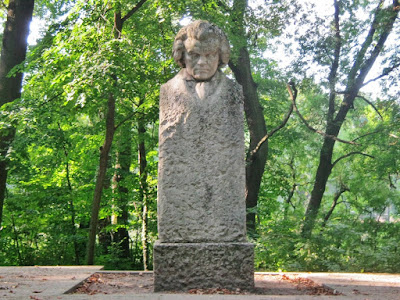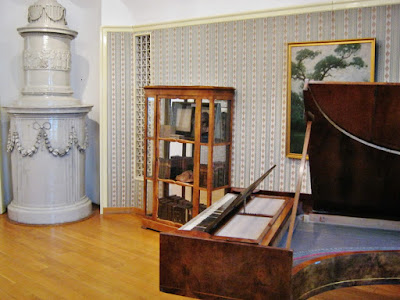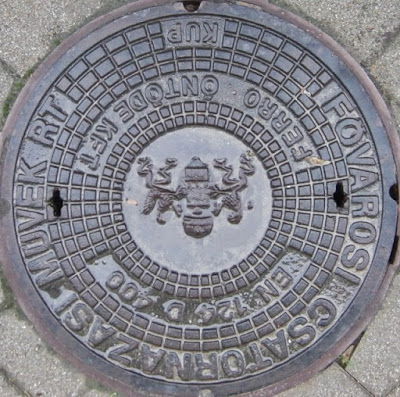Wednesday 23rd September 2015, Budapest
As my Gran’ used to say, “My feet have really been giving me gipp”. I never knew what gipp was but it always sounded painful and curable only with a nice cup of tea in a comfy chair – “to take the weight off”. I now know what she meant. It’s all the walking we’ve been doing on our aged feet. I’m also very stiff from my recent fall. Still, who at our age can still claim to be in perfect health? Keep going while we still can is our motto and Ian makes sure we do. Where does he get his energy from?
Today we returned to the excellent, no nonsense étterem near the flat for lunch. We were served with lots of fresh vegetables and rice and a meaty paprika stew. Because the restaurant is so good we’d decided to linger in the flat this morning catching up on domestic chores like the laundry and sorting out the blog. Thus we had lunch at the étterem before continuing out for the afternoon.
Feeling replete we took the metro out to Déli Pályaudvar on the southern side of the city. From here we joined a clean, air conditioned train which carried us in comfort in the direction of Székesfehérvár. The train was smart and spotless. When the ticket inspector arrived we feared we’d be clapped in irons for travelling without a ticket outside of the city but they smiled cheerfully, nodded and passed on by. What have we done that we should be treated so kindly in this country while migrants in genuine need cannot receive the same hospitality and welcome?
We alighted after half an hour at the typical little rural Hungarian town of Martonvásár. A ten minute walk brought us to the entrance of a lovely park surrounding an eighteenth century palace. It has been altered since then and now has a neogothic façade.
We were on a sort of pilgrimage, following in the steps of Ludwig van Beethoven. The palace had belonged to the Brunszvik family and Beethoven had been a friend who spent considerable time there. He taught the daughters of the family music and composed several pieces while staying there.
Nowadays the castle is occupied by the National Institute of Agriculture and access is not permitted, though for less than a pound we could explore the grounds, walk around the lake and on to the island where in high summer it is possible to attend lamplight concerts of Beethoven’s music given from a bandstand in the heart of the woods. (Probably get bitten by mosquitoes though!)
There is a side entrance to the castle giving access to a small museum dedicated to Beethoven and the Brunszvik family. Here we sat in the cool reading an idiosyncratic translation into English about the composer as we listened to a cd of his music. He came across as a far more sympathetic person than I had previously considered him to be. I was surprised to discover his hearing became irreparably damaged by the time he was in his early 30s! Yet some of his greatest compositions were created after this happened. His music has always seemed loud and heavy. It now seems obvious that this is because he could feel the music through its vibration whereas something light and sparkly such as Mozart, would be impossible for him to feel in the same way. He has always seemed a ponderous, severe composer, heavy jowled and lacking humour. It transpires that he was romantically attached to either one of the Brunszvik daughters - Josephine, or to her cousin - Giulietta Guicciardi both of whom he taught while staying at the palace. He is known to have composed his Moonlight sonata and the Appassionata to an unknown lady and it is thought likely to have been one or other of them. Having already visited both his birthplace and an incredibly intellectual - and to me incomprehensible - exhibition about his works in Bonn it has been interesting to discover a different and more human side to his nature. I’d never realised either that he was only in his early 50s when he died. (Ian says it’s obvious from this how little I understand about classical music and how can I refer to Mozart as sparkly? So be it.)
There was another member of the family however, that we also wanted to know about. Theréz Brunszvik, who was also taught piano by Beethoven and became a close friend. She was deeply interested in the work of the Italian educationalist Pestalozzi. She was considered to be amongst the most intelligent and highly educated women in Hungary and decided to devote her life to the education and wellbeing of very young children. Until the mid 19th century European society was not interested in the education of children below the age of six. In England the first nursery school was set up in 1817 but they did not appear on the continent for another decade. Theresa Brunszvik set up her nursery school in Buda in 1828. It was the first in Central Europe and her influence led to others opening in Austria and Southern Germany.
A museum traced the development of nursery education with examples of teaching aids developed by the German specialist in the education of young children, Friedrich Fröbel. His methods, together with those used in England, became the standard for nursery schools throughout Hungary in the 1860s.
Staff and children had to make all the teaching aids and toys themselves, frequently using natural objects such as nuts, straw, leaves and maize. They also had responsibility for 60 to 100 children each.
The exhibition described not simply the pioneering work of Theréz Brunszvik. her peers and her followers, but went on to illustrate the development of nursery teaching in the private sector from around 1910. These private nurseries adopted the techniques of Maria Montessori, still so popular today.
The exhibition also covered the way Communist rule affected the teaching methods used in nursery schools in Hungary, particularly in the 1950s and 60s when it was compulsory to follow the Soviet methods of teaching.
Despite a complete language barrier the museum curator made it clear, when we attempted to ask when he closed, that we should spend plenty of time exploring this fascinating collection. It was only as we left we realised the museum should have closed at 4pm and he’d waited patiently until gone 4.30. I think we were the only visitors all day. He zipped off home on his bike the second we left.
We strolled down into the heart of the little town – not much more than a village really. Here we found a few single-storey baroque properties serving as general stores, a vendéglö, (once a coaching inn) and a couple of little cafes. We sat outside one of these with a coffee for a much needed rest. Then, with a chocolate ice cream cornet each that cost less than £1 for both, we walked peacefully back beside the park in the cool of the evening to catch the train back to the city. Yet another delightful day.
Thursday 24th September 2015, Budapest
Today we made our longest trip outside of the city yet, travelling to Esztergom some sixty kilometres up the Danube from the city. It is a familiar place to us. We first visited it as long ago as the late 1960s and several times since.
We caught the shabby, rickety, noisy little Hev train from just down the hill at Batthányi Tér and alighted at Arpád Bridge where we thought we could catch a bus to Esztergom. We found no evidence of one so returned to the Hev and continued to Szentendre where we recalled seeing a bus when we were there last week, leaving for Esztergom at the bus station.
The journey took an hour and a half but it was a beautiful ride through pleasant leafy countryside, stopping at every little village along the way. The houses were a delight, their gardens filled with fruit trees and bright late summer flowers – climbing roses and boughs heavy with rustic apples intertwined.
We passed through Visegrád (a Slavonic name meaning High Castle,) another pleasant riverside town picturesquely located on the beautiful Danube Bend while on the hilltop above are the ruined remains of the thirteenth century castle built by King Béla IV as a fortification against further invasion from the Mongols. Visegrád looks across to Nagymaros and the Börzsony mountains on the opposite bank of the Danube while there are lovely wooded hills behind the town. The citadel once served as a repository for the Hungarian crown jewels, until they were stolen in the 15th century! The castle was occupied variously by the Turks and the Habsburgs before being abandoned and left to fall into decay.
It was lunch time when the bus arrived in Esztergom. We were sitting on a seat facing four little girls of around 7 years old squashed together on seats intended for two. They were going on a school trip with all their classmates and three frazzled teachers. Having stared at us closely for a while, no doubt wondering what these strange grown-ups were saying in that funny language, one of the lasses covered her mouth with her hand and whispered something to her friends, They all stared at us and covered their mouths as they exchanged remarks about us. We found this funny as we’d never have understood what they were saying anyway. So we copied them, pointing at them and whispering behind our hands. Soon we were all laughing and we continued playing this silly game until we got off before them in the centre of Esztergom. We then stood outside their bus window waving to them as the bus drove off, laughing with them at our shared silliness despite being unable to actually speak to each other.
We explored the town down by the “little Danube,” a leafy, shady area where the Danube flows around an offshore island as it winds beneath the town. Here we had a pleasant snack lunch on a shady terrace watching a couple of workers vainly attempting to gather up the leaves that has started to fall from the trees. They continued to fall faster than they could be collected. It is still hot and sunny but nature knows it’s not for much longer. Nearby is an open air pool beside what looks like a building in Turkish style.
We continued through the lower town and out on to the island. From here we climbed up to the bridge which now links Hungary with Slovakia on the far side of the Danube. When we first started visiting Esztergom the bridge, constructed in the 1890s, had been partially destroyed during the war, cutting the link between the two countries. Some of the arches were still there but the bridge was just a bombed ruin stretching part way across the river. On our last visit however, about ten years ago, the bridge had been restored and traffic was flowing again between the two countries. Then, and today, we walked across the bridge – because it was there and we could. This time even the passport control has disappeared and the border is completely open. We had wondered whether there may be temporary restrictions imposed as part of the measures to control the movement of migrants. (We’ve been out of touch with the news lately and we are not sure what is happening concerning the migrants arriving in Hungary and trying to travel further to the west.)
We didn’t particularly want or need to go further in to Slovakia so returned across the bridge to Esztergom where Ian lead me to the narrow winding Cat Steps up to the castle. We were the only idiots climbing up that way in the hot sunshine. The path was steep with broken, uneven steps winding their way through the ruins of the old castle. Why do I trust him? Eventually we emerged, hot and sticky, into a ruined vault reeking of urine at the base of the castle! At least we were in shade for the final ascent and we emerged with relief onto the shady lawns that surround the basilica.
After recovering our breath we entered the Basilica, a massive, 19th century neoclassical building. Unadorned on the outside, within it is lined with grey, red, cream and orange marble while the ceilings and cupola are painted with enormous frescoes of saints and religious scenes. It is impressive but, paradoxically perhaps, rather soulless. It is liberally spangled with shiny chalices, bits of saints and skulls of primates – ecclesiastical ones of course! The Catholic Church in Europe is very devout and every church has its prized collection of saintly knick-knacks usually displayed in elaborate reliquaries and sometimes embellished with lace and gold filigree. Apparently in 1996 the right hand of Saint Istvan, housed in the Basilica in Budapest was temporarily reunited with that of his wife Queen Gizella, transported from Passau by the Bishop of Veszprém. Thus the skeletal hands of the blessed couple were linked together again after nearly a thousand years of being dead! Bizarre or what?
Having admired the skull of St Istvan, crowned king on Christmas day 1000, in its very elaborate reliquary we wandered around the huge, impersonal building vainly trying to feel suitably in awe as a large crowd of Japanese tourists clicked away endlessly at an ammonite in the red marble flooring.
We didn’t want to see the collection of religious bling – chalices, mitres, holy rings and bejewelled crosses, so returned to the castle ramparts next to the basilica to admire the late afternoon sunshine on the sublime view of the river, the surrounding hills and the restored bridge linking two towns and two countries.
We made our way back into town. Realising it would take a good couple of hours to get home we decided to catch the next bus back to Szentendre to pick up the train back to Budapest. On the bus we speculated about the Hungarian craze for joining together bits of different saints. We are now working on the prototype for a wholly of holies - His Eminence, St. Frankenstein!
Friday 25th September 2015, Budapest
Today it has been pouring with rain almost non-stop. This morning we went for coffee at the Institut Français and used their wifi for answering emails and loading our latest blog. By then it was time for an early lunch at our “usual” étterem before returning home to dry out. We discovered a couple of umbrellas in the flat and set off again to visit an exhibition of modern Hungarian folk art. Some excellent products – weaving, ceramics, felting, embroidery, dressmaking, hats, carving and furniture.
It wasn’t the weather to potter the streets and we’d discovered a foundry museum so made our way there on a search for Hungarian manhole covers. The museum was excellent, very similar in some respects to the Godin one we visited in Guise back in May. This one had been set up at much the same time in Budapest by a Swiss named Abraham Ganz. He, like Godin, had a paternalistic attitude towards his workers providing them with medical care, accommodation, a pension and education for their children. He became godfather to 64 of his workers’ children. The foundry, while still producing beautiful cast iron stoves as Godin had done, came to specialise in producing train wheels following a process perfected by Ganz. Over 100,000 train wheels were produced in his lifetime. He supplied wheels and equipment to 59 railway companies in 7 countries.
The museum has examples of the foundry’s production ranging from cast iron tomb stones to spiral staircases, stoves, bedheads, bells and cutlery. But no manhole covers!
We asked but were told by a lady with lovely muddled English that she had no idea who or where manhole covers would have been produced in Hungary though obviously they were. Some of the best and most decorated ones we’ve seen are here. Ian explained his enthusiasm and I complained about being dragged around Europe so Ian could photograph as many as possible. She looked sympathetic but felt that men needed a hobby and took us out into the yard so we could see the one there emblazoned with the name of the company that produces the drainpipes around the city. She suggests we give them a try.
We then went off to search for the tomb of the Turkish Pasha Gul Baba buried at a shrine up in Obuda at the top of a very steep hill followed by a flight of seventy steps - I counted them! When we reached it we found it locked and dilapidated with graffiti on the walls and evidence that it was used by drop-outs and drug takers. The Turks were here for some 200 years and it is a pity that there is so little evidence left of their achievements here.
Down below we found the Királyi Baths. These are of Turkish origin and they too are now looking very neglected despite being in daily use. They are the cheapest of the hot springs along this bank of the river but there did not seem many people wishing to use them. They do though look very Turkish and are quite different from the baroque splendour of the Széchenyi baths or the 19th century elegance of the Gellért baths.
Not really feeling hungry after our big lunch we bought a couple of pieces of pizza to have with salad for supper and returned home. Despite the rain it is feeling quite warm and muggy.












































